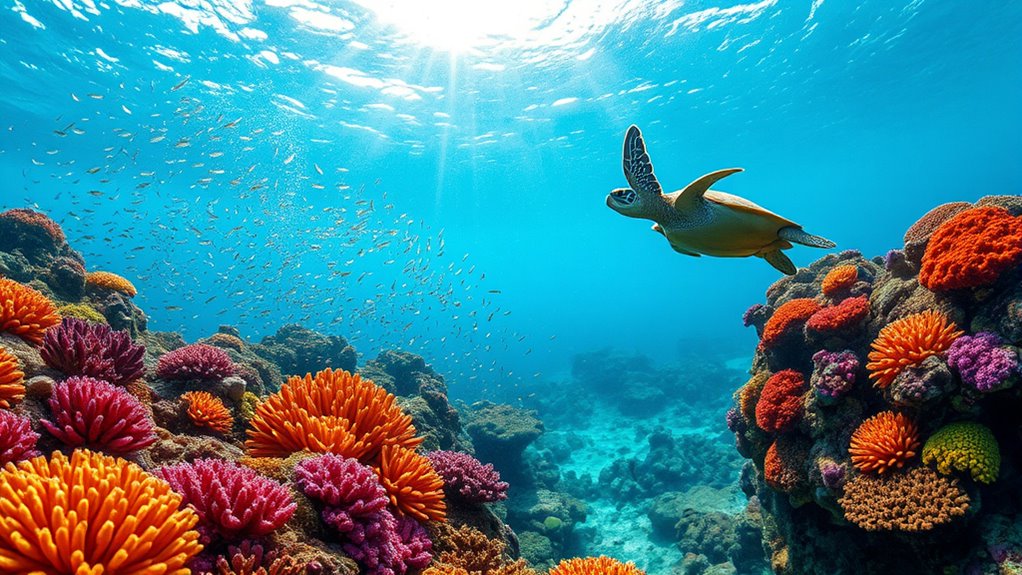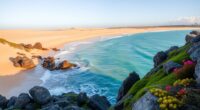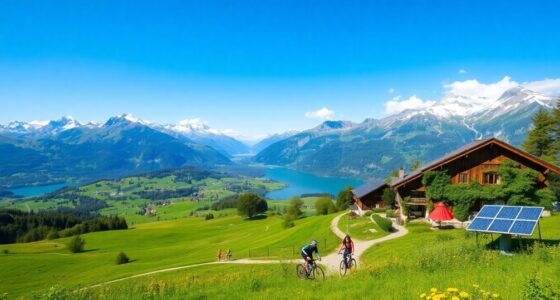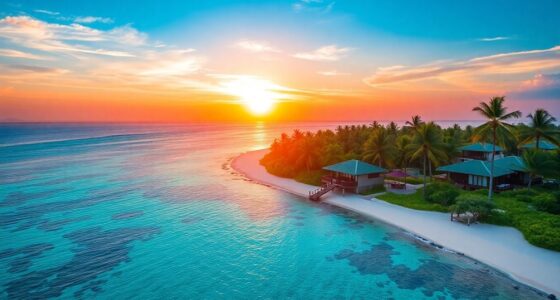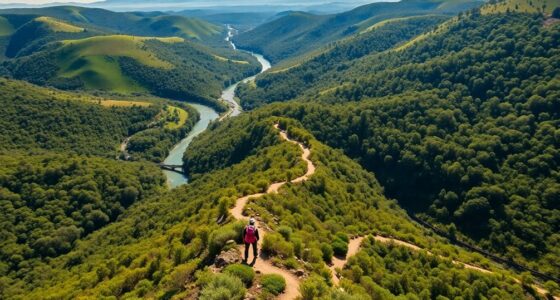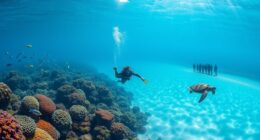Apo Island’s success story shows how community-led marine protected areas (MPAs) can restore coral reefs, boost biodiversity, and improve local livelihoods. Citizens actively participate in conservation, establishing zones that limit overfishing and protect essential habitats. Coral restoration efforts and sustainable tourism further support ecosystem health. This inspiring model demonstrates that local actions can lead to global change, and if you stay tuned, you’ll discover how Apo Island became a beacon of marine conservation.
Key Takeaways
- Apo Island’s community-led marine protected areas have successfully restored coral reefs and increased fish populations.
- Traditional ecological knowledge and active local leadership drive sustainable conservation practices.
- Coral gardening and artificial reefs are key strategies in reef restoration efforts.
- Marine biodiversity, including endangered species like sea turtles, has significantly improved.
- Community involvement and effective policies ensure long-term ecological and economic benefits.
The History and Background of Apo Island
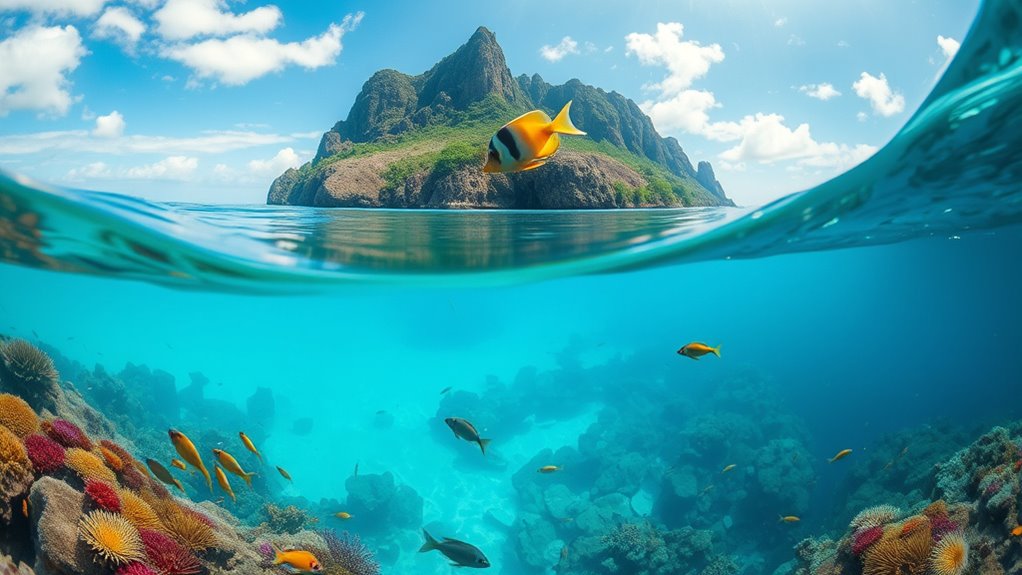
Apo Island has a rich history rooted in its community’s deep connection to the sea. This connection forms the backbone of its cultural heritage, passed down through generations. The island’s residents have long relied on traditional practices like fishing and small-scale farming to sustain their livelihood. These practices reflect their respect for the environment and their understanding of marine ecosystems. Over time, these customs helped preserve local biodiversity and fostered a sense of stewardship among the community. The island’s history is marked by a shared commitment to maintaining its natural resources, which continues to influence its current conservation efforts. By honoring their cultural heritage and traditional practices, Apo Island has built a strong foundation for sustainable living and marine protection. Furthermore, the community’s traditional ecological knowledge has been instrumental in developing effective conservation strategies that align with their way of life.
Challenges Faced Before Conservation Initiatives
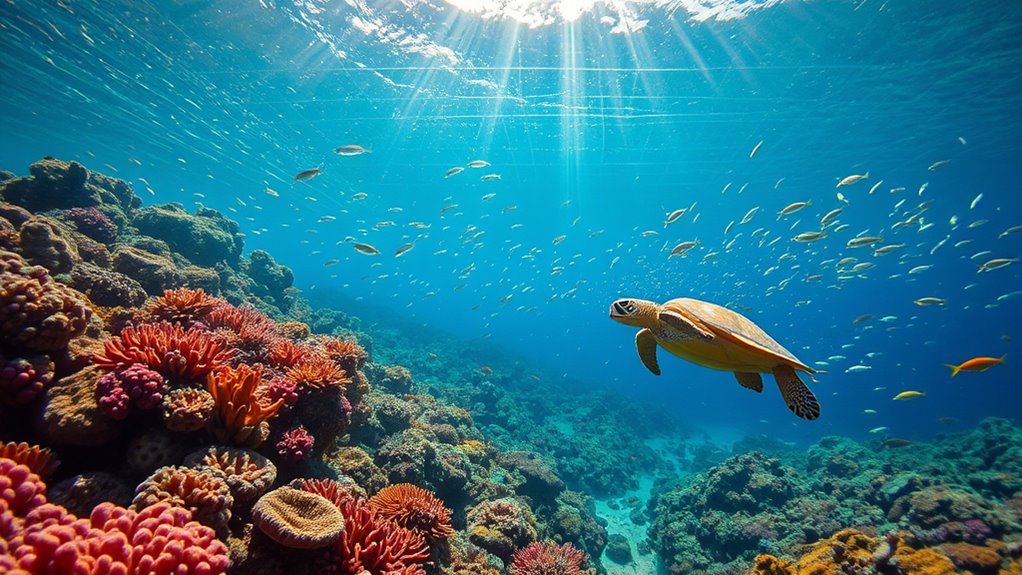
Before conservation efforts began, the island faced severe threats from overfishing, destructive fishing practices, and rapid coral reef degradation. Overfishing reduced fish populations, disrupting the reef’s balance and threatening local livelihoods. Destructive methods like dynamite and cyanide fishing damaged the coral structures, making recovery difficult. Marine pollution, including trash and chemicals, further degraded the marine environment, harming marine life and coral health. These combined pressures led to a significant decline in biodiversity and the overall health of Apo Island’s reefs. Without intervention, the ecosystem risked collapse, endangering both marine species and the community’s food security. Recognizing these threats, local stakeholders knew urgent action was needed to protect and restore the island’s precious marine resources. Additionally, the lack of color accuracy in visual technologies hindered efforts to monitor reef health effectively, emphasizing the importance of precise data collection for conservation.
Community Involvement and Local Stewardship

How did local communities transform their approach to marine conservation? They embraced active local leadership and recognized their essential role in protecting Apo Island’s marine resources. Community involvement shifted from passive acceptance to proactive stewardship, driven by a shared commitment to sustainable practices. They developed eco tourism initiatives that benefits both visitors and residents, fostering economic growth while safeguarding marine life. Local leaders organized patrols, education programs, and resource management efforts, empowering residents to take ownership of conservation. This collective effort cultivated a sense of pride and responsibility, ensuring long-term success. By integrating eco tourism development with local stewardship, the community created a sustainable model that balances environmental health with economic stability. Additionally, they utilized advanced techniques to monitor and protect marine biodiversity more effectively. Your involvement helped turn Apo Island into a shining example of community-led conservation.
Establishment of Marine Protected Areas
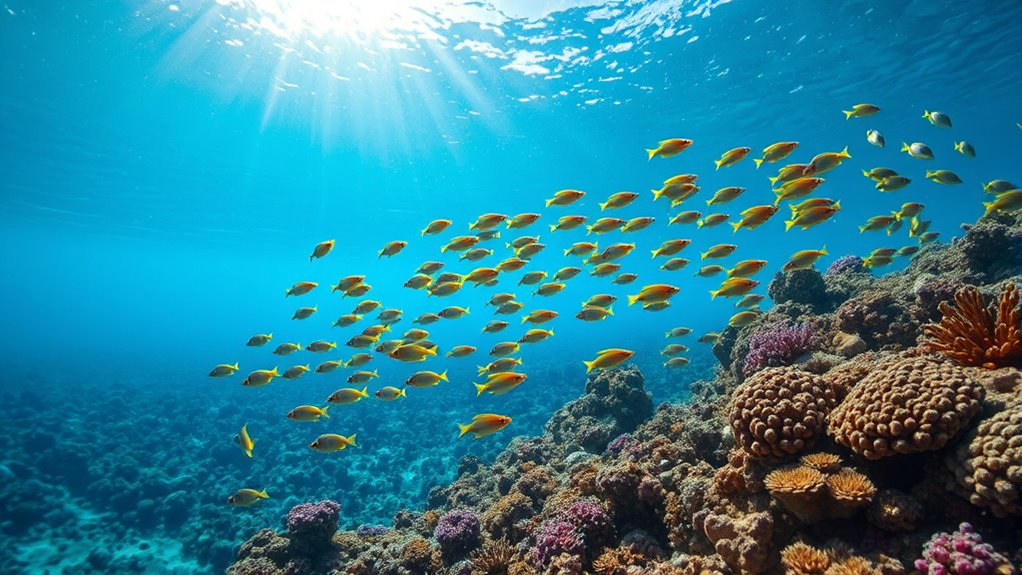
You play a key role in understanding how Marine Protected Areas are designated and where boundaries are set. Community involvement strategies are vital for gaining local support and ensuring effective management. These protected zones greatly boost marine biodiversity, benefiting both ecosystems and local livelihoods. Developing a Cultural Intelligence approach can facilitate better communication and collaboration with local communities to enhance conservation efforts.
Designation and Boundaries
The establishment of marine protected areas (MPAs) on Apo Island is a crucial step in conserving its rich marine biodiversity. Clear designation and boundaries are essential for effective tourism development and fisheries management. By defining specific zones, authorities ensure that coral reefs, fish populations, and habitats are shielded from overexploitation. These boundaries help prevent illegal fishing and habitat destruction, supporting sustainable use. Properly marked zones also guide tourists to designated areas, minimizing environmental impact while enhancing their experience. Precise boundaries foster cooperation among local fishers, tour operators, and conservationists, creating a unified approach. Additionally, the use of best waterwick pots and other sustainable tools can contribute to reducing environmental impacts within these protected zones. Overall, establishing clear MPA boundaries on Apo Island safeguards its ecological integrity while promoting responsible tourism and sustainable fisheries.
Community Involvement Strategies
Community involvement plays a vital role in establishing effective marine protected areas on Apo Island. You can foster community engagement by involving local fishers, residents, and leaders in decision-making processes. This guarantees everyone understands the importance of reef preservation and feels responsible for its protection. Education campaigns, workshops, and regular meetings help build awareness and commitment. By empowering community members to participate in monitoring and enforcement, you create a sense of ownership that strengthens reef preservation efforts. When locals see tangible benefits from protected areas, such as increased fish stocks or tourism income, they become more motivated to uphold conservation rules. Your active engagement helps sustain these areas long-term, guaranteeing Apo Island’s reefs remain healthy and resilient for future generations. Additionally, regular maintenance of marine protected areas ensures their effectiveness and longevity, supporting ongoing conservation success.
Impact on Marine Biodiversity
How does establishing marine protected areas (MPAs) on Apo Island influence marine biodiversity? MPAs help restore coral health, reducing risks like coral bleaching caused by rising sea temperatures. When fishing is restricted, fish populations rebound, supporting a balanced ecosystem. This recovery discourages invasive species from taking hold, as healthier native corals and native fish outcompete invaders. Protecting reefs also preserves diverse habitats that support various marine life, from tiny invertebrates to larger species. Over time, these efforts increase biodiversity, making ecosystems more resilient to environmental stresses. Establishing MPAs creates protected habitats that are essential for the recovery and sustainability of marine ecosystems. Without MPAs, coral bleaching events and invasive species could devastate marine life, but Apo Island’s protected status fosters a thriving, diverse ocean environment that benefits both marine species and local communities.
Coral Reef Restoration and Rehabilitation Efforts
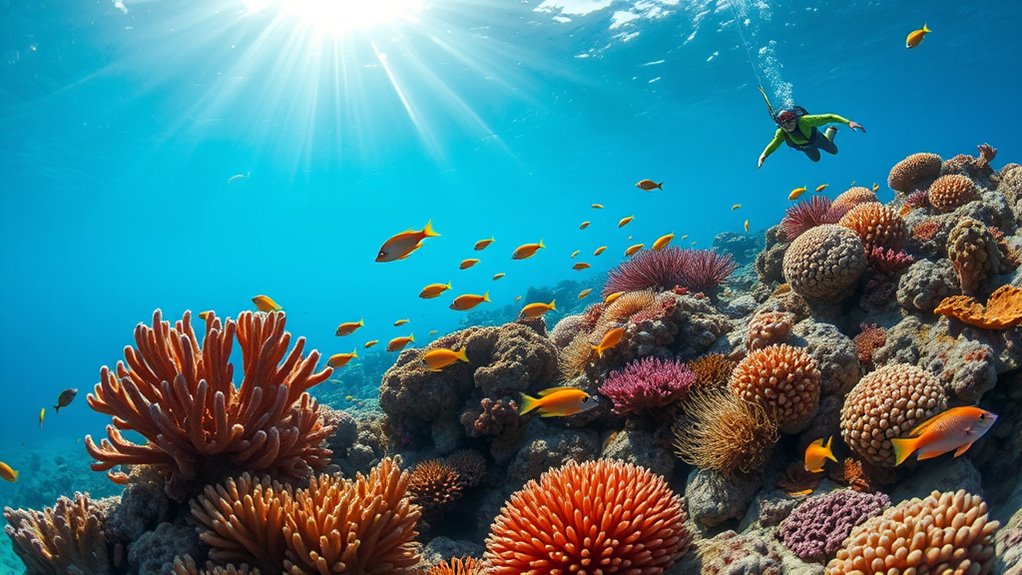
Coral reef restoration and rehabilitation efforts on Apo Island have gained momentum as local communities and conservation groups recognize the urgent need to repair damaged ecosystems. You’ll find initiatives addressing coral bleaching and the impacts of overfishing, which threaten reef health. Restoration projects include coral gardening, where healthy fragments are cultivated and transplanted onto degraded areas, and the installation of artificial reefs to encourage new growth. Active community participation is essential, ensuring sustainable practices and ongoing monitoring. Key strategies include:
- Coral nursery cultivation and outplanting
- Enforcing fishing regulations to reduce overfishing impacts
- Removing invasive species that hinder coral recovery
- Implementing effective filtration and pump protection measures to maintain equipment and support ongoing restoration activities
These efforts aim to rebuild resilient reefs that can withstand environmental stresses, ultimately supporting marine biodiversity and local livelihoods.
The Role of Sustainable Tourism in Conservation
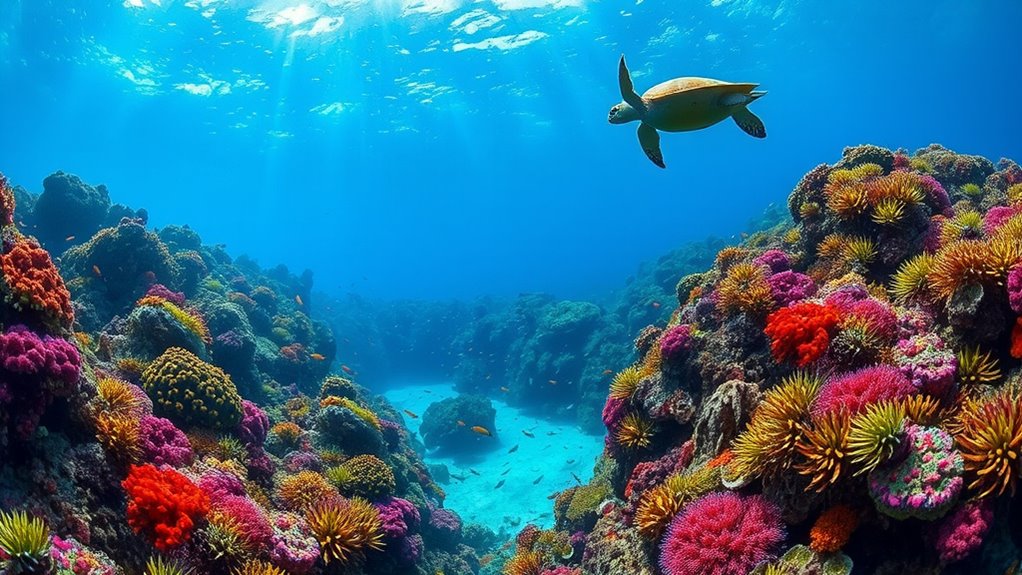
Have you ever wondered how tourism can serve as a powerful tool for conservation? Sustainable tourism, especially eco-tourism, offers clear benefits for Apo Island’s marine environment. By attracting eco-conscious travelers, it generates income that supports reef protection and local preservation efforts. This approach encourages visitors to respect the natural habitat, reducing harmful activities and promoting responsible behavior. More importantly, it empowers the local community, giving residents a stake in conservation success. Community empowerment means locals participate in managing tourism activities, benefit financially, and become advocates for marine protection. This creates a positive feedback loop: conservation efforts thrive because the community is invested, and tourism continues to flourish sustainably. Additionally, understanding the principles of environmental adaptation can help ensure that tourism practices remain sustainable and beneficial for future generations. Together, eco-tourism benefits both Apo Island’s ecosystems and its people.
Marine Biodiversity and Key Species Found on Apo Island
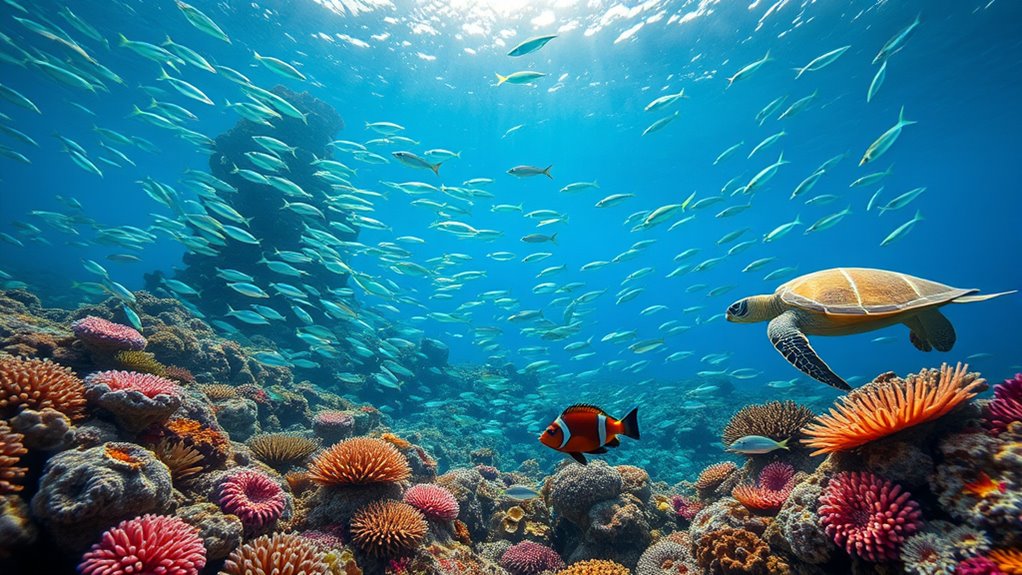
Apo Island boasts vibrant coral reef ecosystems teeming with diverse life. You’ll find iconic marine species like clownfish and sea turtles, which draw visitors from around the world. Additionally, the island plays a vital role in protecting endangered fish populations, highlighting its importance for marine conservation. The protection measures help sustain marine biodiversity, ensuring the health of the ecosystem for future generations.
Rich Coral Reef Ecosystems
Beneath the surface, vibrant coral reefs teem with life, creating one of the most diverse marine ecosystems in the region. These ecosystems support a wide array of species, but they face threats like coral bleaching caused by rising temperatures and overfishing impacts that disturb ecological balance. You’ll notice healthy corals providing shelter and food for numerous marine creatures. However, stressors threaten this richness, risking the loss of biodiversity. To better understand the ecosystem, consider:
- The resilience of reefs that recover after bleaching events
- The importance of habitat complexity for marine species
- The role of conservation efforts in mitigating overfishing effects
This delicate balance underscores the importance of marine protected areas, like Apo Island, in preserving these vibrant reef systems for future generations.
Iconic Marine Species
What makes Apo Island’s marine environment truly remarkable are its iconic species that symbolize the richness of its biodiversity. You’ll find vibrant sea turtles, especially the endangered green and hawksbill turtles, gracefully gliding through clear waters. These species are crucial indicators of healthy ecosystems. However, coral bleaching caused by rising sea temperatures and marine pollution threaten their habitats. When corals bleach, they lose their color and resilience, jeopardizing the entire reef system and the species that depend on it. Despite these challenges, Apo Island’s conservation efforts help protect these key species. By reducing marine pollution and promoting reef resilience, you help ensure that these iconic creatures continue to thrive, showcasing the island’s success in safeguarding marine biodiversity for future generations.
Endangered Fish Populations
The vibrant marine life that populates Apo Island includes several endangered fish species that highlight the importance of preserving biodiversity. These species, such as the Napoleon wrasse and some groupers, benefit greatly from the island’s marine protected areas. By restricting fishing and promoting coral reef restoration, conservation efforts help sustain these critical populations. You’ll notice that:
- Marine protected areas create safe habitats, allowing endangered fish to recover and reproduce.
- Coral reef restoration enhances habitat complexity, supporting the survival of vulnerable species.
- Active community involvement ensures ongoing protection and monitoring of key species.
Together, these strategies bolster the resilience of Apo Island’s marine ecosystem, securing a future where endangered fish populations can thrive again. Your participation in conservation efforts directly contributes to this success story.
Impact of Conservation on Local Communities
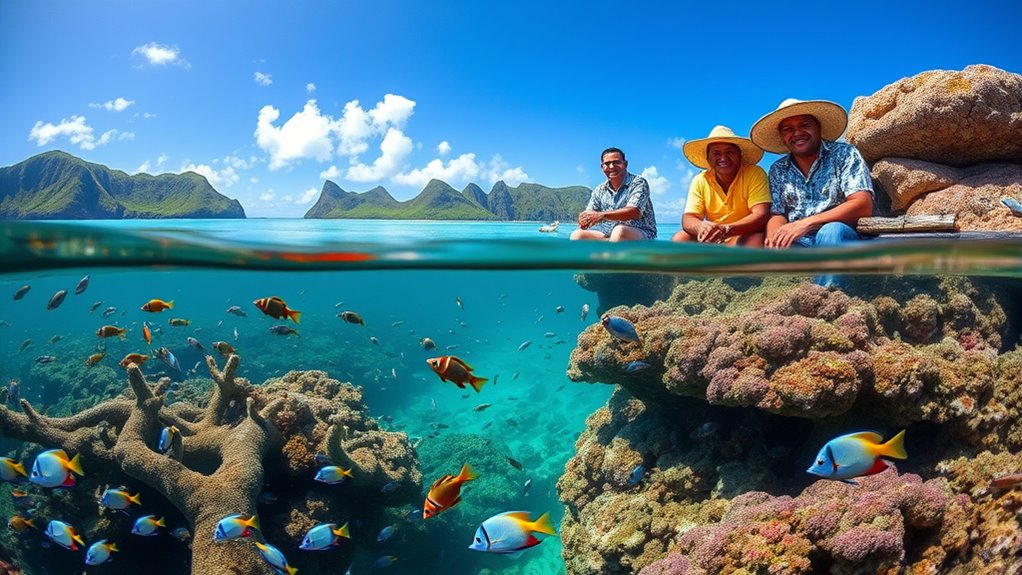
Conservation efforts on Apo Island have considerably transformed the lives of local communities. With improved fisheries management, fish populations have rebounded, providing more reliable catches for fishermen. This stability boosts their income and reduces overfishing pressures. Simultaneously, tourism development has flourished as visitors come to see the vibrant reefs and marine life, creating new economic opportunities. Local residents now benefit from guiding tours, selling crafts, and providing accommodations, which diversifies their income sources. These positive changes foster a sense of pride and encourage sustainable practices. Overall, the combined impact of conservation has strengthened the community’s resilience, ensuring both ecological health and economic well-being for future generations.
Lessons Learned and Future Prospects

You can learn a lot from Apo Island’s success by focusing on community engagement strategies that inspire local participation. Implementing sustainable management practices guarantees long-term conservation, but ongoing policy and funding support are essential to keep these efforts alive. Moving forward, strengthening these areas will be key to maintaining and expanding Apo Island’s positive environmental impact.
Community Engagement Strategies
What lessons can be learned from Apo Island’s community engagement strategies to guarantee their success? First, involving local residents in decision-making fosters ownership and compliance, especially regarding fishing regulations. Second, promoting sustainable marine tourism benefits both the community and conservation efforts. Finally, continuous education and awareness campaigns keep stakeholders informed and motivated. To strengthen these strategies, consider:
- Encouraging community-led enforcement of marine protected areas
- Integrating local knowledge into marine tourism development
- Providing economic incentives tied to sustainable practices
Sustainable Management Practices
Building on community engagement strategies, implementing sustainable management practices guarantees long-term health of Apo Island’s marine ecosystems. Effective marine policy plays a essential role in this, establishing clear regulations that protect marine life while supporting local livelihoods. Fisheries management is central to these efforts, ensuring that fish stocks are harvested responsibly and sustainably. You learn that enforcing no-take zones, seasonal closures, and size limits helps maintain ecological balance. Continuous monitoring and adaptive management are critical, allowing you to adjust strategies based on scientific data and community feedback. These practices foster resilience, prevent overfishing, and promote biodiversity. Ultimately, sustainable management practices, grounded in strong marine policy and fisheries management, ensure Apo Island’s reefs thrive for future generations.
Policy and Funding Support
How have policy frameworks and funding sources shaped Apo Island’s conservation success, and what lessons can be drawn for the future? Strong marine policy and targeted funding initiatives have been essential. They provided the legal foundation and financial resources necessary for effective management and enforcement. By establishing clear regulations and securing sustainable funding, Apo Island built resilience against environmental threats. Key lessons include:
- The importance of integrating community participation into marine policy development.
- Securing diverse funding sources to ensure long-term protection.
- The need for adaptive policies that evolve with ecological and social changes.
These strategies fostered a collaborative approach, ensuring ongoing support and resource availability. Moving forward, continued innovation in policy and funding will be crucial to sustain Apo Island’s marine protected area and replicate its success elsewhere.
How Apo Island Inspires Global Marine Conservation Movements

Have you ever wondered how a small island like Apo Island has sparked a global wave of marine conservation efforts? It’s because Apo Island proves that sustainable marine tourism and effective fisheries management can protect marine ecosystems. Its success shows communities worldwide that local actions matter. By establishing marine protected areas, Apo Island attracts divers and eco-tourists, which boosts local economies while conserving biodiversity. This model inspires other regions to adopt similar strategies, demonstrating that community involvement and scientific research lead to positive change. Apo Island’s story encourages global movements to prioritize conservation, balancing human needs with marine health. Your support for such initiatives helps spread these impactful practices, making Apo Island a beacon for marine stewardship worldwide.
Frequently Asked Questions
What Specific Policies Support Apo Island’S Marine Protection Efforts?
You see that effective marine protection relies on clear policies, community engagement, and enforcement strategies. Specific policies include establishing marine protected areas, regulating fishing activities, and involving local communities in decision-making. Enforcement strategies include patrols, penalties for violations, and community-led monitoring. These combined efforts empower locals, guarantee compliance, and help sustain marine ecosystems, making protection policies successful and long-lasting.
How Is Scientific Research Integrated Into Apo Island’S Conservation Strategies?
Imagine a living blueprint guiding your every move—scientific research does just that for Apo Island. You actively incorporate data on coral restoration and fish populations to shape conservation strategies. This ongoing research reveals what works best, allowing you to adapt practices, monitor progress, and guarantee marine life thrives. Your commitment to evidence-based action transforms hope into tangible success, safeguarding Apo Island’s vibrant underwater world for generations to come.
What Funding Mechanisms Sustain Apo Island’S Marine Protected Areas?
You’ll find that Apo Island’s marine protected areas are maintained through diverse funding mechanisms, including marine tourism revenues and community engagement programs. These strategies generate funds directly from visitors and involve locals in conservation efforts, creating a sustainable financial model. By promoting eco-friendly tourism and empowering the community, Apo Island ensures ongoing support for its marine protected areas, fostering both ecological health and economic stability.
How Do Local Traditions Influence Conservation Practices on Apo Island?
You’ll find that local traditions heavily influence conservation practices on Apo Island. The community’s deep respect for cultural heritage fosters strong community engagement, making conservation efforts more effective. Fishers and villagers often incorporate traditional practices that promote sustainable fishing and protect marine resources. By valuing cultural heritage, residents actively participate in preserving their environment, ensuring the success of marine protected areas and strengthening the bond between tradition and conservation.
What Are the Long-Term Ecological Impacts Observed Since Protection Measures Began?
Think of the reef as a thriving garden, where protection measures have allowed it to flourish. Since these measures began, you’ve seen remarkable coral recovery and a boost in fish populations, transforming the ecosystem into a vibrant underwater metropolis. These long-term ecological impacts show a resilient reef reborn, proving that conservation efforts truly turn back the tide of degradation, ensuring healthier, more diverse marine life for generations to come.
Conclusion
Apo Island’s success shows that when communities unite and take action, they can turn the tide for their oceans. Your commitment to protecting marine life makes a real difference, proving that “a journey of a thousand miles begins with a single step.” By supporting conservation efforts, you help guarantee these vibrant ecosystems thrive for generations to come. Remember, every small act counts in safeguarding our planet’s precious waters.

